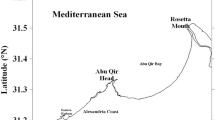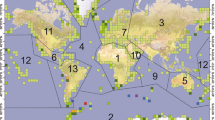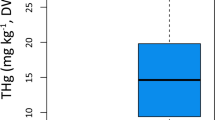Abstract
THE possibility that cadmium may be an environmental pollutant has caused concern because it has toxic effects on many animal species including man, rat, rabbit, chicken, quail, and pigeon1–4. The occurrence of cadmium in wildlife is not unusual and samples of marine species taken from around the British coast contain low levels (less than 0.5 mg per kg in fish and less than 2 mg per kg in most shellfish); however, levels of up to 93 mg per kg were present in limpets, Patellasp., collected from areas of natural mineralisation or industrial sources of cadmium5. Seabirds generally contain higher residues than marine invertebrates. For example, Anderlini et al.6 examined the amounts of nine metals in the livers of seven Antarctic and Pacific seabird species and noted that the maximum mean cadmium residue occurred in 10 ashy petrels Oceanodroma homochroa collected from their breeding grounds in California (mean residue was 53.2±20.5 mg per kg). Parslow et al.7 found up to 22.3 mg per kg dry wt cadmium in livers of eight puffins Fratercula arctica collected live from various British breeding colonies. It was suggested that pelagic birds might contain higher residues than coastal living species because a single fulmar Fulmarus glacialis examined by them contained 159 mg per kg cadmium. Anderlini et al. concluded that there was a correlation between increased concentration of cadmium in birds and exposure to industrial influences. Parslow et al. did not attempt to explain the residues they found in puffins, but Bourne8 concluded that individual birds were becoming increasingly contaminated through feeding near areas of local pollution around the British coast. It is debatable whether cadmium should be regarded as a pollutant to seabirds. We report here the occurrence of cadmium residues in the tissues of apparently healthy, breeding seabirds which are considerably higher than any previously found. More important, we conclude that the cadmium has a natural rather than an industrial origin, since we have found high cadmium residues in a marine insect, Halobates, which is widely distributed in tropical regions far from sources of industrial cadmium. This insect is only one example of the sources from which birds obtain their cadmium residues.
This is a preview of subscription content, access via your institution
Access options
Subscribe to this journal
Receive 51 print issues and online access
$199.00 per year
only $3.90 per issue
Buy this article
- Purchase on Springer Link
- Instant access to full article PDF
Prices may be subject to local taxes which are calculated during checkout
Similar content being viewed by others
References
Friberg, L., Piscator, M., Nordberg, G. F. & Kjellström, T. Cadmium in the Environment (CRC Press, Cleveland, Ohio, 1971).
Lofts, B. & Murton, R. K. J. Reprod. Fert. 13, 155–164 (1967).
Richardson, M. E., Fox, M. R. S. & Fry, B. E. Jr, J. Nutr. 104, 323–338 (1974).
Pritzl, M. C., Lie, Y. H., Kienholz, E. W. & Whiteman, C. E. Poult. Sci. 53, 2026–2029 (1974).
Cohen, M. in Problems of the Contamination of Man and his Environment by Mercury and Cadmium 543–570 (Commission of the European Communities, Luxembourg, 1973).
Anderlini, V. C., Connors, P. G., Risebrough, R. W. & Martin, J. H. in Proc. Symp. Conserv. Probl. Antarctica (ed. Parker, B. C.) 49–62 (Virginia Polytechnic Institute and State University, Blacksburg, 1972).
Parslow, J. L. F., Jefferies, D. J. & French, M. C. Bird Study 19, 18–33 (1972).
Bourne, W. R. P. in Marine Pollution (ed. Johnston, R.) 403–502 (Academic, London, 1976).
Mead, C. J. Bird Study, 21, 15–86 (1974).
Lloyd, C. Bird Study 21, 182–216 (1974).
Leatherland, T. M., Burton, J. D., Culkin, F., McCartney, M. J. & Morris, R. J. Deep-Sea Res. 20, 679–685 (1973).
Cheng, L., Alexander, G. V. & Franco, P. J. Water Air Soil Pollut. 6, 33–38 (1976).
Boyle, E. A., Scalter, F. & Edmond, J. M. Nature 263, 42–44 (1976).
Cramp, S., Bourne, W. R. P. & Saunders, D. The Seabirds of Britain and Ireland (Collins. London. 1974).
Ashmole, N. P. & Ashmole, M. J. Bull. Peabody Mus. nat. Hist. 24, 1–131 (1967).
Cheng, L. Mar. Fish. Rev. 36, 1–7 (1974).
Author information
Authors and Affiliations
Rights and permissions
About this article
Cite this article
BULL, K., MURTON, R., OSBORN, D. et al. High levels of cadmium in Atlantic seabirds and sea-skaters. Nature 269, 507–509 (1977). https://doi.org/10.1038/269507a0
Received:
Accepted:
Published:
Issue Date:
DOI: https://doi.org/10.1038/269507a0
This article is cited by
-
High Levels of Heavy Metals detected in Feathers of an Avian Scavenger Warn of a High Pollution Risk in the Atacama Desert (Chile)
Archives of Environmental Contamination and Toxicology (2021)
-
Quantitative analysis of relative tectonic activity in the Acıgöl fault, SW Turkey
Arabian Journal of Geosciences (2018)
-
Lead and Cadmium in the Blood of Nine Species of Seabirds, Marion Island, South Africa
Bulletin of Environmental Contamination and Toxicology (2014)
-
Age-dependent accumulation of heavy metals in liver, kidney and lung tissues of homing pigeons in Beijing, China
Ecotoxicology (2013)
-
Wintering areas of adult Atlantic puffins Fratercula arctica from a North Sea colony as revealed by geolocation technology
Marine Biology (2010)
Comments
By submitting a comment you agree to abide by our Terms and Community Guidelines. If you find something abusive or that does not comply with our terms or guidelines please flag it as inappropriate.



